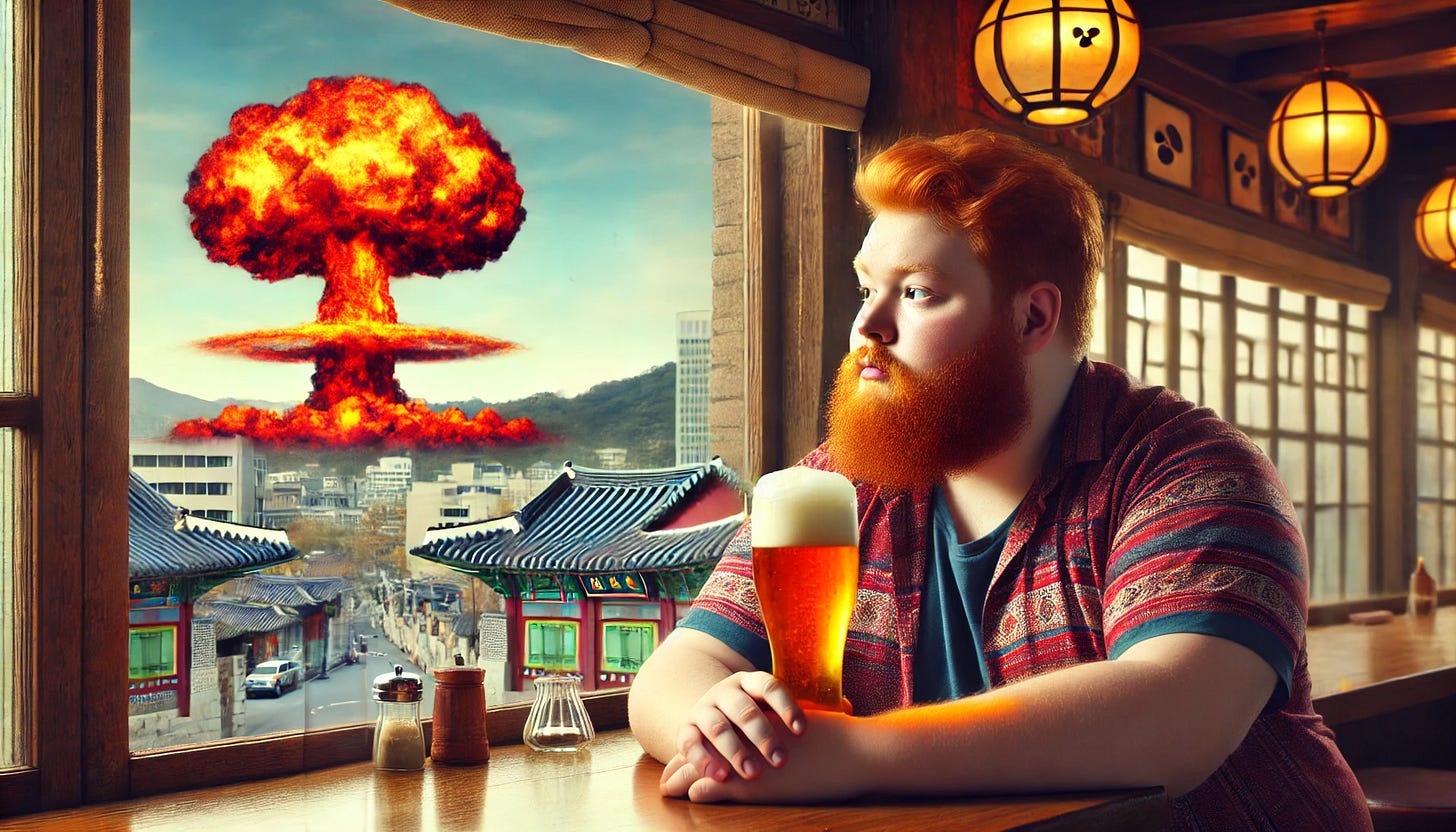We are living in a simulation… and Korea is at the center!
It's a perfect script: North Korea has nukes, South Korea wants them, and both sit at the nexus of China, Russia, Japan, and the US.
You sit in a bar in Seoul, lift your beer and look at the two inches of head that the greenhorn server left on your lager. You drink your way through the froth and get to the amber heaven. Your phone buzzes, you glance down and read a breaking news alert: “Suspected North Korean nuclear test”. Last week it was ROKUS training exercises, a North Korean missile hurled over Japan, and a U.S. aircraft carrier heading to the Korean Peninsula. Another predictable escalation that almost seems too well timed and scripted. You return to your beer and notice two inches of foam once again bury your lager??? You look back at your phone, the nuclear test and your beer… is it just deja-vu?
Corny Matrix introductory narratives aside, what if we are living in a simulation? Could Korea be at the center of that simulation?
Nick Bostrom’s simulation hypothesis—first proposed in 2003—argues that one of three possibilities must be true:
Civilizations never reach a point of technological maturity capable of creating simulated realities.
Civilizations reach that point but choose not to simulate their ancestors.
We are almost certainly living in a simulation because advanced civilizations would likely create countless simulated worlds.
Now, if we are, in fact, living in a simulation and this simulation is created by advanced beings that share similarities to ourselves, then the question then becomes: What is the simulation for? There are several clues that could help us answer this question, prominent amongst these are the narratives fed into the simulation (the similar stories told across humanity), and the collective subconscious (the emotional and cognitive patterns shared across humanity), which frame our understanding and actions.
The first prominent clue is the stories we take as given. Across humanity, there are similar stories that revolve around cycles of creation, collapse, and rebirth. Empires rise and fall, and catastrophic events—whether natural disasters or human conflicts—redefine entire eras. The threat of nuclear apocalypse stands out as the most striking modern expression of this pattern. It embodies the ultimate collapse scenario, a global reset point that forces humanity to confront its survival instincts and ethical limits. In a simulation, these cycles culminate in stress tests, points to measure human adaptability, moral evolution, and capacity to navigate the brink of annihilation.
The second prominent clue is the collective subconscious. Across humanity, the panoply of human emotions do not vary (excluding han?). Fear, hope, and the looming specter of destruction are not isolated to any one culture; they are deeply ingrained in the human experience, resonating across geography. Global anxieties around war and survival connect individuals on a subconscious level, creating shared emotional landscapes. In a simulation, these emotions shape and constrain collective identities, structuring decision-making and action.
An easy way to think of it is through computer game design. If you were creating a computer game, you want a strong narrative that consumes and engages the player, and you want to elicit and evoke emotion because emotional engagement ensures immersion. In a well-designed game, challenges are crafted to test the player’s resilience, adaptability, and capacity to learn from failure. The highs and lows—the triumphs and defeats—are what make the experience memorable and meaningful.
Similarly, in a simulation, shared human experiences of struggle, joy, fear, and hope could be intentional design elements, meant to evoke growth and transformation on an individual and collective scale.
Just as game developers introduce increasingly complex levels and moral dilemmas to push the player’s understanding and creativity, the simulation may do the same by presenting humanity with escalating challenges. Technological advancement, environmental crises, and political upheaval could serve as tests designed not to punish but to push us toward new modes of thinking, cooperation, and ethical evolution - and here’s where the Korean Peninsula comes into it.
Think about it: the Korean Peninsula is a microcosm of the most pressing challenges facing human civilization. It’s the last vestige of the Cold War, with North Korea as a nuclear-armed state locked in an uneasy stalemate with the democratic South. For decades, experts have called it a “powder keg,” yet it never quite explodes. Every crisis brings us to the brink but never over the edge—almost as if the simulation won’t let it happen yet. But what if the simulation is accelerating? Consider these recent developments:
North Korea’s expanding nuclear arsenal and increasingly advanced missile technology.
South Korea’s debate over developing its own nuclear weapons in response to the North’s growing threat.
The shifting balance of global power, with the U.S.-China rivalry placing the peninsula at the intersection of competing spheres of influence.
If we are living in a simulation that seeks to understand how civilizations collapse under the weight of technological and geopolitical tensions, then the Korean Peninsula is the ideal case study. It’s a concentrated arena where questions about deterrence, human irrationality, and the fragility of peace can play out on a small but highly symbolic stage.
Bostrom’s hypothesis posits that any sufficiently advanced civilization might destroy itself before reaching the capability to simulate entire worlds. Nuclear weapons are one of the clearest paths to such a collapse. They represent both technological triumph and existential risk—a sword of Damocles hanging over every human civilization that has ever discovered them.
In this context, North Korea’s nuclear program and South Korea’s potential nuclearization are not just regional security concerns; they are the simulation’s stress test. The choices made on this peninsula could determine whether the simulation concludes in survival or annihilation. If the simulation is about understanding the fragility of human civilization, then the Korean Peninsula is the critical data point, the place where everything hangs in the balance.
But what makes it even more compelling—and terrifying—is the human element. While the logic of deterrence keeps the region from spiraling into full-scale war, the unpredictability of human leaders, emotion, and political miscalculation introduces an element of chaos into the simulation. One wrong step, one misinterpreted missile launch, and the entire simulation could crash.
If the simulation hypothesis is true, then the Korean Peninsula is no longer just a regional flashpoint; it’s the center of the story. The choices made by leaders in Seoul, Pyongyang, Washington, and Beijing could be the final chapters in a much larger narrative—a cosmic experiment to see how civilization ends.
The only answer is, every time a greenhorn server gives you more than the appropriate head on your beer, blow the froth off the top - violently! If this is a simulation, and Korea is at the center, and we are sliding uncontrollably towards annihilation, why the f&*k do we have to put up with two inches of head on our beers???




